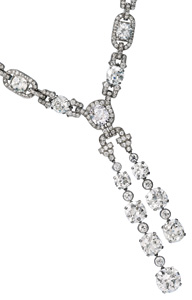 |
Cartier diamond sautoir
|
Auctions are a lot like gambling. The auction house takes in
jewelry and gems, betting that they will sell. Some items are a sure thing and
others are more of a long shot.
Ultimately, buyers determine whether or not the gamble pays off.
Sotheby’s gambled on a long shot in its December 7 Magnificent Jewels sale by
putting almost half of the sale value into two lots. In the end, the auction
house took a hit when those two lots failed to sell.
The sale garnered $30,398,818 against a presale estimate of
$50 million and was sold 66.5 percent by lot and 45.5 percent by value. This
compares to a total of $53,228,590 for the December 2010 sale and $39,367,500
for its sale eight months earlier in April of 2011. But, despite the fact that
the market is getting used to higher jewelry auction sale totals, the December
2011 sale is not as discouraging as it appears at first glance.
Top Lots
Four of the top ten lots did reach over $1 million. The top
lot of the day was a 23.62-carat, G, VS1, oval-shaped diamond ring, which sold
for $1,874,500* to an Asian private collector. It was followed by the storied
1924 Cartier diamond sautoir that was the property of a prominent American
family active in publishing and politics. The piece sold for $1,650,500, also
to an Asian private collector. The family that consigned the sautoir was in the
room for the sale and was very pleased by the result.
Gambling
Auctions are all about finding the rare, the unusual, the
historic and the unique. Sotheby’s gambled on two very rare, high-value lots in
this sale, which accounted for $20 million of the $50 million presale total.
And both of those lots — the Light of Golconda and the 22.17-carat intense pink
diamond — failed to find buyers.
The Light of Golconda, a 33.03-carat, D, internally
flawless, type IIa, was a truly magical stone. Cut in the late 1700s or early
1800s, the diamond had an old-world charm not found in newly cut stones. The
fact that it is a type IIa gave the diamond a special luminosity. It was a
wonderful stone that required a true connoisseur to fully appreciate its
uniqueness. With a $7 million estimate, the price was high.
“It was a premium price for a premium stone,” said Gary
Schuler, head of Sotheby’s jewelry department in New York. “The Golconda was
risky,” observed Lisa Hubbard, chairman of the international jewelry
department, North and South America. “The most interesting privates were
looking at it. These were people who think outside of the box, who can have
anything and who have seen it all, but, for this time, the stone didn’t find a
buyer. The Golconda was a gamble, an object more than a stone to be figured on
a per-carat basis — and we just did not find the collector for it.”
Hubbard also noted that some women were concerned about the
spread of the stone on their hand as it was a shallow cut, with a large table.
Perhaps the stone would have fared better had it been set as a pendant. Some
dealers also commented on the shallowness of the stone. Bidding stopped at $6.4
million, just shy of the $7 million required to buy it.
The second big lot of the day — an intense pink 22.17-carat
square cut — also went unsold. It,
too, was a beautiful stone, a pleasing pink with even color saturation in an
unusually large size. But color diamonds are tricky. Everyone sees color
differently and it is a very personal preference. At $13 million — slightly
less than $590,000 per carat — it was well priced for a private, but a bit high
for the trade, and bidding stopped at $11,200,000. “The trade is cash poor.
Everyone says business is not good and they could not support the bulk money of
the pink, even though the per-carat estimate was reasonable,” noted Hubbard.
Going Strong
Once those two lots were out of the picture, the sale, which
faltered with a large number of buy-ins, had some surprisingly strong moments,
which brought the total to a respectable
$30.4 million, a sum that a couple of years ago would have pleased everyone.
“We got some amazing prices for jewelry, particularly Cartier and Van Cleef
& Arpels,” explained Hubbard. “White diamonds over 10 carats did well, not
spectacularly, but the results were solid in a softening diamond market. White
diamonds under 10 carats were soft and that is a sign of the times.”
The bright spot of the day was the “Elegant John Traina”
single-owner sale. A prominent San Francisco businessman, who was once married
to author Danielle Steel, Traina, who died in 2011, was known for his sense of
style and refined taste. The 92-lot collection was 100 percent sold and brought
in $1,921,755 of the day’s sale total. It was one of the most extensive
collections of men’s jewelry ever to come to auction and it was filled with
well-designed pieces with fine-quality gems. Bidding was very competitive,
pushing prices to unexpected highs.
It seems that the auctions globally, while continuing to do
well, are taking greater risks with the jewelry that is put on the block.
Sometimes the gamble pays off and sometimes it does not. However, prices paid
for gems and jewelry at auction in the recent past have soared to unprecedented
heights, boosting the bottom line ever higher and overshadowing the fact that a
high percentage of lots are left unsold. Going forward, the question that comes
to mind is “Will the market continue to climb, or has it peaked?” The answer to
that question will come in the spring, when a new round of auctions launches.
*All prices include buyer’s premium.
Article from the Rapaport Magazine - January 2012. To subscribe click here.